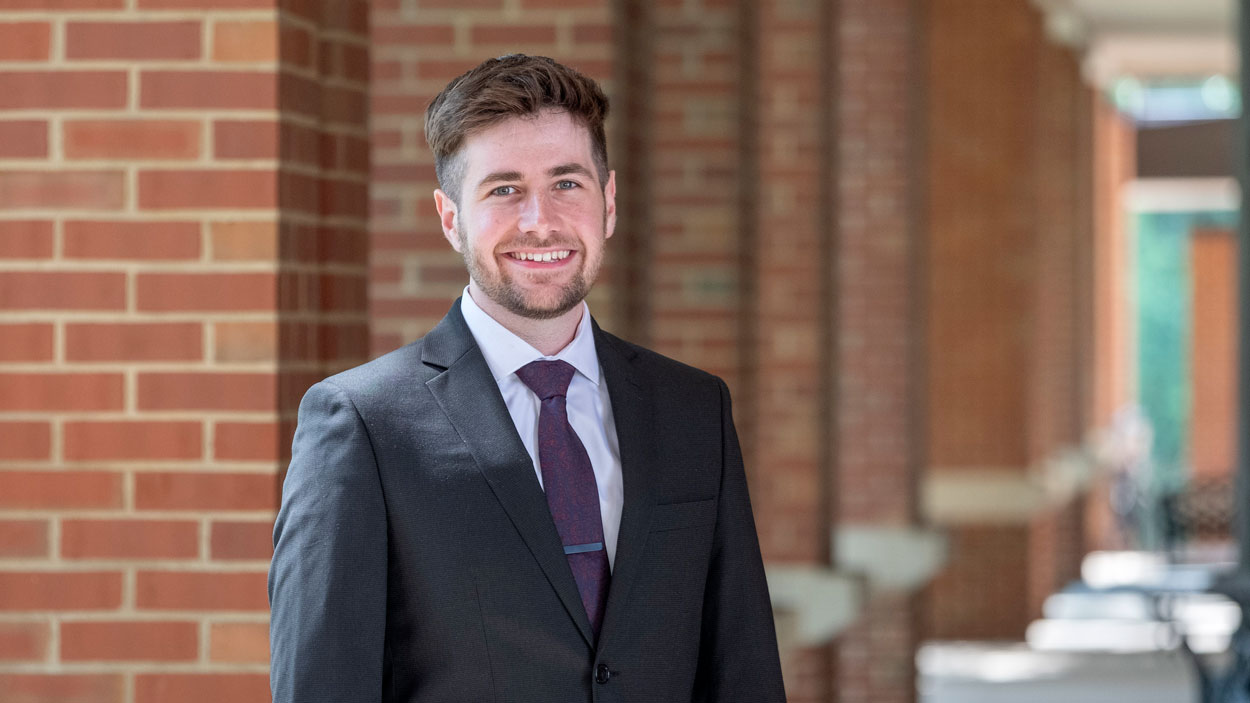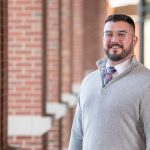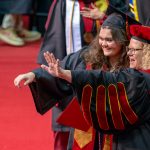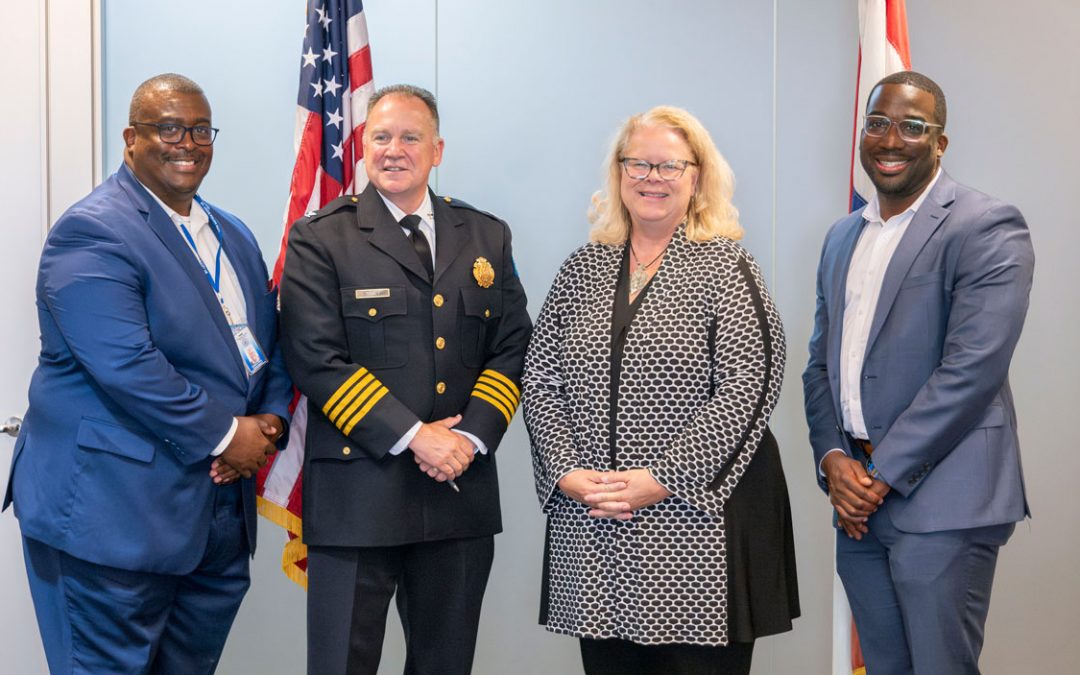
Luke Little recently earned his DNP from the College of Nursing at UMSL. His project looked at ways to reduce the amount of time patients go NPO, or “nothing by mouth.” (Photo by Derik Holtmann)
The Doctor of Nursing Practice program at the University of Missouri–St. Louis encourages its students to identify problems to address in their own clinical practice. And that’s exactly what Luke Little, who earned his DNP from the College of Nursing this month, did while working as an emergency room nurse.
Little had been working at Mercy Hospital in St. Louis when he and his wife relocated to Hanover, New Hampshire, so that she could begin her studies at Geisel School of Medicine at Dartmouth. He began working in the emergency department at a hospital in New Hampshire, where he did the majority of his clinical rotations for the DNP program. The hospital sees a large number of geriatric patients and offers a wide range of services tailored to this population, including a dedicated Geriatric Emergency Department.
While working at the hospital, Little started to notice that many of his geriatric patients would go for long stretches – eight hours or longer – without being able to eat or drink. At the vast majority of hospitals and emergency departments across the country, the general practice – referred to as NPO, an abbreviation of the Latin phrase “nil per os,” which translates to “nothing by mouth” – is that patients cannot eat or drink anything unless a physician or health care provider explicitly states it. But prolonged NPO status can be a critical safety issue for geriatric patients, leading to increased rates of delirium, hypoglycemia and perioperative complications.
As Little began talking with the leadership at his hospital, many physicians and nurses also identified prolonged NPO status as an issue facing their patients. In reviewing the level one Geriatric Emergency Department Accreditation criteria, he noticed they were recently updated to include NPO times in geriatric patients as a key quality indicator.
“While it was first noted in my own clinical practice as a potential problem, it was also identified by the organization to be a high-priority problem, which is another part of the DNP process that this project was able to meet,” Little said. “We identified that problem and then tried a couple different things to fix it.”
For his DNP project, Little implemented a nurse-driven intervention to decrease NPO times in the geriatric emergency department. He designed a required documentation tool for electronic health records that prompted nurses to obtain a diet order from the provider and looked at whether or not this tool would reduce the length of time that patients were kept NPO.
His project saw a statistically significant reduction in both the time that patients were kept fasting and the number of people who were kept fasting longer than eight hours. Prior to the project starting, 47 percent of geriatric patients would go 8 hours or longer without being able to eat or drink. Through the project, Little was able to reduce that number down to 40.8 percent.
“It’s highly significant statistically speaking, but also clinically speaking, because that 6.2 percent of patients represents quite a high number of patients who are now receiving diet orders that never would have received diet orders in the past,” Little said.
His project also saw a significant drop in the amount of time that passed from provider assignment – essentially, when the provider puts in a diet order – to arrival time, from six hours down to almost five. Little acknowledges that there is still work to be done; the goal of the project was to get that number down to the standard time, which is two hours.
While Little has completed his DNP project – he successfully defended his project in mid-July – his quality improvement initiative is ongoing. He’s received a lot of buy-in from physicians and nurses at his hospital to reduce NPO times and views his DNP project as the first step in a complete paradigm shift. The hospital is switching to an “everybody eats” model, in which all patients can eat and drink when they come into the emergency department unless a provider explicitly says otherwise.
Little’s work is having a direct impact at his own hospital, but he believes it can have a much wider influence, too. He points to previous research that has shown that prolonged fasting is a direct cause of delirium, which in turn comes with its own complications, including a prolonged length of stay and, ultimately, patient harm.
“The thinking is that by decreasing this direct cause of delirium, we’re able to decrease patient harm and improve patient experience in the emergency department,” he said. “Everyone’s happier when they can eat or drink and they’re not kept waiting for longer than eight hours. This is not just an isolated problem at our hospital; it’s kind of generalized to the whole western emergency department paradigm of fasting. It’s a nationwide issue that needs to be addressed. It’s not evidence-supported, it’s not beneficial to the patients and it causes problems for the nurses and providers. I hope that this research is able to give more validity to the fact that this is something that needs to change, and that it’s something that is able to be changed.”
Having completed his DNP, Little plans to take boards as soon as possible and would ideally like to work in family medicine, emergency medicine or both. Down the road, he’d like to get his Emergency Nurse Practitioner board certification and continue his education in public health programs. He was drawn to the nursing model of health care for its holistic, patient-centered approach and said that UMSL’s DNP program had a major impact on him as a nurse, both from a clinical and research perspective.
“The program at UMSL was able to help me really develop a love for quality improvement and also shape my understanding of what it looks like,” Little said. “That was a little bit of a difficult mindset switch for me coming from traditional bench research, and it really has given me a passion for improving care processes in the hospital through the models that a Doctor of Nursing Practice gives you the tools for – knowing change theory, knowing models of implementing evidence-based practice, knowing how to navigate complex politics of the health care system. In the clinical portion, I do feel like I was very well-prepared for my clinical rotations and that the didactic portion of the degree prepared me very well to do the skills. The professors were very instrumental in my success in the clinical portion and encouraging to me as a DNP student.”














